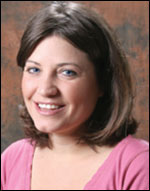
Am Fam Physician. 2009;79(4):263
Author disclosure: Dr. Baginsky is a speaker for Sanofi-Aventis and Novo Nordisk. He has also received funding from Lifescan, Inc. for a study being conducted through Touro University—California.

Around my 15th birthday I was diagnosed with type 1 diabetes. I had all the classic signs and symptoms, from frequent thirst and urination to extreme weight loss. My blood sugar was 1,040 the morning I was diagnosed, and my weight was 102 lb (I’m 5 ft 5 in). The medical staff was in disbelief that I was still walking around and that I appeared to be functioning normally.
Over time, I became healthy again. As my blood sugar levels came down to a normal range, my body began to return to a healthy weight. I developed a fear that my weight would continue increasing and never stop. I began cutting back on my insulin to lose a few pounds. When I moved away to college, I started using insulin manipulation again to lose weight. This time, my body was more fragile. One night, I was nauseated, throwing up, and on the verge of diabetic ketoacidosis. I realized I no longer needed to wait until my blood sugar became dangerously high to throw up; I could just make myself do it. It was then that I came to believe that, between insulin manipulation and bulimia, I had found the perfect “diet”.
I lied to everyone about how I was managing my diabetes. When asked what my blood sugar was, I would throw out a number like 120, when really it was 700. I made up my blood sugar charts, lied about taking my insulin, and did everything to avoid having my A1C levels checked because it would reveal I was not taking my insulin. (My highest A1C level was 18 percent.)
I hit bottom two years ago when I was admitted to the ICU following a three-day binge-and-purge cycle, in which I had turned my pump down to deliver almost no insulin. After I left the hospital, my doctor helped me get into an outpatient eating disorder treatment program.
Today, I am still on the road to recovery. Along my journey, I have met so many wonderful medical professionals, without whom I might have given up a long time ago. I hope that, by using my voice, I can help start an eating disorders recovery program designed specifically for people with diabetes, to help save them from the devastating effects of “diabulimia”.—k.g., 26
COMMENTARY
How common is “diabulimia”? Eating disorders are more common in preteen girls, teenage girls, and young women with type 1 diabetes, and they should be discussed in first visits with these patients. Approximately one in three young women with type 1 diabetes skips or reduces insulin doses to lose weight. Not surprising, these women tend to have poorly controlled diabetes, with a higher risk of complications and higher mortality.1
Although preteen and teenage girls are often preoccupied with appearance, those with type 1 diabetes typically have additional risk factors for an eating disorder, including poor self image because of chronic illness, intensive focus on diet, and a tendency toward weight gain associated with insulin use. But, unlike their counterparts without diabetes, they have an extremely effective, but dangerous, means of rapidly losing weight—insulin omission.
K.G. had been coming to me for more than a year when she hit bottom after a potentially fatal episode of diabetic ketoacidosis, the direct result of using her insulin pump to deliver inadequate doses. By then, she was ready to discuss treatment, and had enough trust in me to accept referral to an eating disorders program.